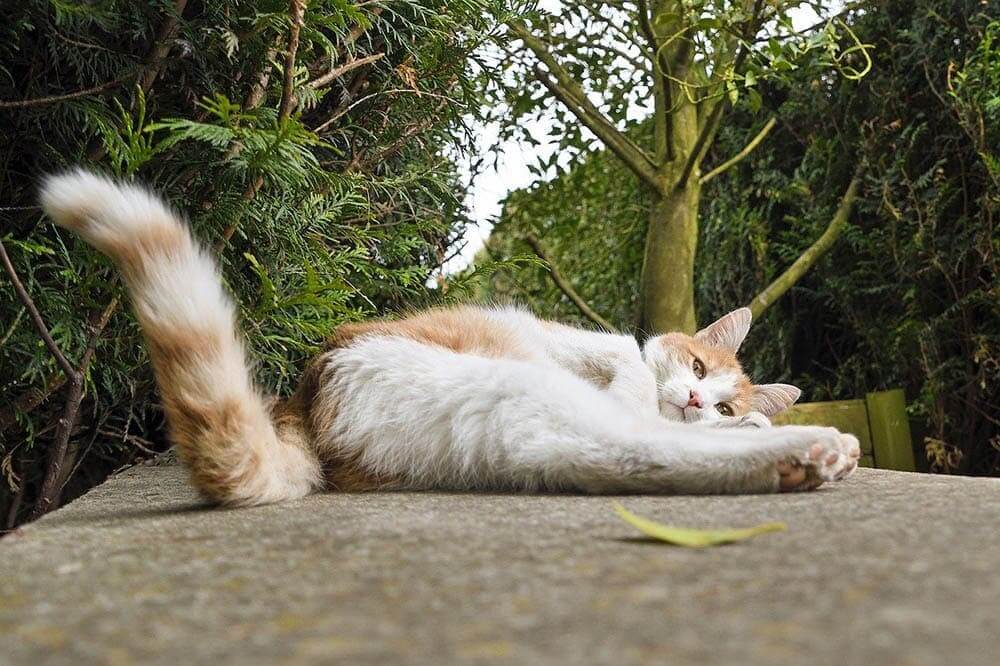The tail is one of the biggest communication tails used by cats.
For instance, when your kitty lashes her tail, she is essentially telling you she’s agitated.
When she is focused on something like a toy, her tail will wave from side to side in slow motion.
The tail-up posture with a curve at the end signals that she’s approaching amicably.
Knowing how to interpret your kitty’s tail language will improve your relationship with your pet.
Today let’s talk about cats puffing their tails when they die.
When your kitty puffs up her tail, you know she is angry, scared, or enjoying playtime.
However, it can get confusing if the cat shows this behavior when she dies.
Does it mean that your beloved fur baby is still alive?
Is there hope that she will be okay again?
Sadly, some cats also puff up their tails when they die.
It is part of the natural dying process. Here, I have detailed 5 reasons why your cats’ tails may puff up when she dies.
1. Muscle Contraction
The appearance of a puffed-up tail is nothing more than the erection of the tail’s hair.
It may appear as though the organ has suddenly increased in size but that’s not the case at all.
What causes the puffing up is the contraction of a cat’s hair erector (Arrector pili) muscles.
These are tiny muscles attached to your kitty’s hair follicles.
When they contract, the hairs in the skin stand – a phenomenon known as piloerection.
It is the same situation as goosebumps in humans.
Your body causes your hair strands to erect in very cold environments.
When a cat is excited, scared, or dying, the Arrector pili muscle located at the tail may contract and consequently cause the muscles to puff up.
The contraction of the muscle is mostly involuntary.
2. The Action Of The Autonomic Nervous System
The action of the hair erector muscle is largely controlled by the autonomic nervous system also known as the vegetative nervous system.
This is the section of the peripheral nervous system that controls smooth muscle, internal organs, and glands.
It mainly acts unconsciously and regulates functions such as digestion, heart rate, pupillary response, and respiratory rate among others.
Death and stressors such as fear and cold can stimulate the nervous system and trigger contraction of the Arrector pili muscle resulting in the puffing up of the tail.
3. A Drop In Blood Pressure
The Arrector pili muscle is also activated when the blood pressure of a cat drops suddenly.
As the kitty approaches her end of life, the heart will pump blood abnormally or stop at once.
Since blood stops circulating throughout the body or does so poorly, blood pressure will dip.
This series of events may trigger the hair erector muscle to contract and puff up the tail in the process.
The likelihood of puffing up is increased in cases where the cat dies suddenly than in a slow death.
4. Fear
Cats also puff up their tails when they are scared or threatened to appear big and hopefully scare away the animal or person threatening their safety.
Sometimes even a sudden noise can trigger the cat to puff up its tail.
Assuming a cat is scared at the point of death and her tail is puffed up, it can remain this way a few minutes after death as well.
Perhaps she got attacked out in the wild by a dog and dropped dead with her tail double its size.
It could also have been a car accident that knocked her dead after she’d puffed up her tail.
5. Bent Or Curled Tail
Here’s a fun fact: cats with curved or bent tails are more likely to have puffed-up tails when they die compared to those with straight tails.
It all boils down to the strength (or lack thereof) of the Arrector pili muscle above.
This said muscle is not always strong enough to lift up the tail of a dead cat.
It happens sometimes but not always.
However, if a cat already has a curved or bent tail, the Arrector pili muscle can cause it to erect and puff up even after death.
Related: Cats with Kinked Tails: Everything You Need To Know
Closing Thoughts
Watching a dying cat is a horrid experience for any cat owner.
One always hopes that their pet will come back to life despite the sight of despair.
This is especially true if the tail of the cat is puffed up.
Unfortunately, a dead cat can have a puffed tail just like a breathing one.
It can be any of the reasons above.
But it may not stay puffed up for too long as the body goes into total rest.

Hi! I am Eleanor Price. I started this website after my cat, Louie, almost died from a case of botulism (a type of food poisoning often caused by bacteria that grow on food items). Turned out that my cat’s diet was the problem. I have made it my duty to provide the best information and recommendations about everything cat lovers need to know about their felines’ health and wellbeing. My goal is to find the most informative content on anything feline-related and share it with fellow hardworking kitty lovers.

